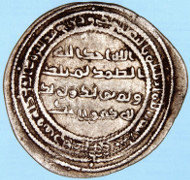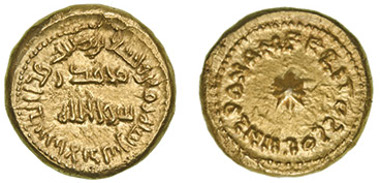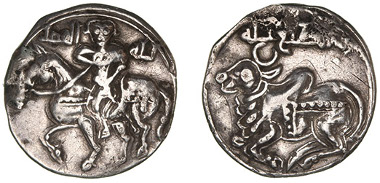09-04-2014 – 01-01-1970
Important Coins of the Islamic World
High quality coins of the Islamic World
On April 10, 2014 London-based auction house Morton & Eden offered high quality Islamic coins totalling £527,640. Auctioneer James Morton said: “This successful sale confirmed that there is serious interest in the collecting of high quality Islamic coins. Of the 85% sold total most lots were knocked down to collectors or agents acting on behalf of collectors. Indeed, it is very much a collector-driven market. The important Umayyad dinar of 91h from ‘The Mine of the Commander of the Faithful’ was withdrawn from this auction following an allegation concerning its provenance and once this has been addressed we anticipate re-offering this interesting coin in a future auction.”
And this is the top ten list of the auction (Prices shown include the Buyer’s Premium of 20%.):
Lot 20: UMAYYAD, TEMP. ‘ABD AL-MALIK B. MARWAN (65-86h). Dirham, Tukharistan ‘8’ (80h or 78h). Mosanef, F. and M.T. Saffar, ‘An Umayyad dirham of Tokharistan,’ JONS 217 (Autumn 2013), p. 8, this piece. Very fine or better, historically important and of the highest rarity.
Tukharistan was the name of a large district to the east of the great city of Balkh, extending along the southern bank of the Oxus river as far as the mountains of Badakhshan, and stretching south as far as the mountain ranges north of Banjhir and Bamiyan. This Umayyad dirham is the only known coin from any dynasty with this mint name.
According to Mosanef and Saffar, at the time of the Muslim conquests Tukharistan was ruled by a Sasanian governor. During the caliphate of ‘Uthman (23-35h) the famous governor of Khurasan, ‘Abdallah b. ‘Amir, sent forces eastwards into Tukharistan under the command of Ahnaf b. Qays. Ahnaf soon captured Marw, and after defeating a large Sasanian army moved on to capture several towns before finally entering Balkh, where the two sides signed a peace treaty. Some years later Firuz, son of the last Sasanian king Yazdigerd III, invaded Tukharistan in an ill-fated attempt to restore Sasanian rule. He was defeated in 47h and fled to China, after which Tukharistan seems to have remained relatively peaceful for the next thirty years.
The next phase of eastward expansion began in 78h when al-Hajjaj b. Yusuf appointed Muhallab b. Abi Sufra to the governorship of Khurasan. Muhallab spent two years in Tukharistan while his son campaigned further east as far as Bukhara. Another decade of eastern conquests under Qutayba b. Muslim Bahili was to follow.
Although Mosanef and Saffar read the date on this coin as thamanin, ‘eighty’, it is in fact clearly thaman, ‘eight’. This may be intended for thamanin as they suggest, but another possibility might be that the decade has been omitted for reasons of space and thaman wa saba‘in, ‘seventy-eight’, was meant. This would coincide with the appointment of Muhallab b. Abi Sufra and so would fit equally well, if not better, with Mosanef and Saffar’s historical account. The four pellets in the margins are unparalleled on other Umayyad dirhams and may also support the earlier date, since five annulets had become established as the standard pattern on coins of 79h and later.
Estimate: £50,000-70,000. Sold for £54,000 ($90,304). Purchased by a private collector.
Lot 10: UMAYYAD, TEMP. HISHAM (106-125h). Dinar, al-Andalus 106h. REFERENCES: Museo Nacional Arqueológico Nacional, Madrid, item 104279 =Vives 19 = Walker p. 102, Mad. 4 = Bernardi 44Aa (citing this as the sole example known). CONDITION: Weakly struck and some scuffs on the obverse, very fine and excessively rare.
Estimate: £20,000-30,000. Sold for £45,600 ($76,257). Purchased by a private collector.
Lot 9: UMAYYAD, TEMP. HISHAM (105-125h). Dinar, Ifriqiya 107h. REFERENCES: Bernardi 44Ca (citing two examples); cf Spink Zurich auction 22, 17 March 1987, lot 22, same dies. CONDITION: Traces of die rust, about extremely fine and extremely rare.
Estimate: £15,000-20,000. Sold for £36,000 ($60,203). Purchased by a private collector.
Lot 16: UMAYYAD, TEMP. HISHAM (105-125h). Dirham, al-Andalus 128h. CONDITION: Clipped, graffiti in reverse field, good fine and of the highest rarity, apparently unpublished.
An unrecorded date for the mint of al-Andalus. Klat lists no dirhams from the mint between 125h and 129h, noting that reported examples from 126h and 127h are considered dubious (Klat p. 291). Hitherto, no dirham at all seems to have been reported for the year 128h.
Estimate: £10,000-15,000. Sold for £22,800 ($38,128). Purchased by a private collector.
Lot 68: ABBASID, AL-MUQTADIR (295-320h). Dinar, Tabariya 299h. REFERENCE: Bernardi 242Gi (date not listed). CONDITION: Small crimp at edge, otherwise good very fine and extremely rare, apparently unpublished. Estimate: £8,000-12,000. Sold for £19,200 ($32,108). Purchased by a UK dealer.
Lot 6: ARAB-LATIN COINAGE, TEMP. SULAYMAN (96-99h). Gold Solidus/Dinar, al-Andalus 98h. REFERENCES: Bernardi 35Aa, same dies as C.0003; Balaguer 42 = Walker p. 79, C.18, same reverse die. CONDITION: Extremely fine and very rare.
This one-year bilingual type was probably introduced by al-Hurr b. ‘Abd al-Rahman, who was appointed to govern Spain after Ayyub b. Habib was removed from office (see note to previous lot). It represents the first instance of the Arabic script being used in Muslim Spain. As Bernardi points out, the Arabic legends are elegantly and correctly written while the Latin inscriptions are abbreviated and more coarsely executed. It is noteworthy that the Hijri year ‘98’ is clearly and completely rendered in Arabic, while the Roman numerals, which would denote the date in Latin characters, are in fact missing entirely from this particular die. It is difficult to escape the conclusion that the Arabic version was considered more important than the Latin by the issuing authorities.
Estimate: £8,000-12,000. Sold for £16,800 ($28,095). Purchased by a US dealer.
Lot 50: ABBASID, AL-MU‘TADID (279-289h). Dinar, Nisibin 284h. REFERENCE: Bernardi 211Hg. CONDITION: Extremely fine and very rare.
Estimate: £3,000-4,000. Sold for £7,440 ($12,442). Purchased by a US dealer.
Lot 60: ABBASID, AL-MUQTADIR (295-320h). Dinar, Hims 309h. REFERENCE: Bernardi 242Gd (date not listed). CONDITION: Parallel striations on flan, about extremely fine and of the highest rarity, apparently unpublished.
Estimate: £6,000-8,000. Sold for £7,200 ($12,041). Purchased by a private collector.
Lot 70: ABBASID, AL-MUQTADIR (295-320h). Dinar, al-Masisa 307h. REFERENCE: Bernardi 242Fd (date not listed). CONDITION: Flan very slightly wavy, otherwise almost extremely fine and of the highest rarity.
This unpublished coin represents the latest known date for dinars from the mint of al-Masisa.
Estimate: £7,000-10,000. Sold for £7,200 ($12,041). Purchased by a private collector.
Lot 82: ABBASID, AL-MUTI‘ (334-363h). Donative dirham, without mint or date. REFERENCE: Ilisch B I 5, citing a single example (not illustrated). CONDITION: From a mount (as is common with donative pieces), light scratches on reverse, almost very fine and of the highest rarity.
This remarkable type is ultimately derived from the bull-and-horseman drachms of the Hindu Shahi dynasty, struck circa 850-950AD. Examples for al-Muqtadir are known in gold and in silver (the latter in some numbers), including one variety which preserves two Brahmi characters above the bull on the reverse. Why such a distinctive type should have been revived under al-Muti‘ is unclear.
Estimate: £4,000-6,000.Sold for £6,600 ($11,037). Purchased by a UK dealer.
For more information on Morton & Eden go to the website of the auction house.








